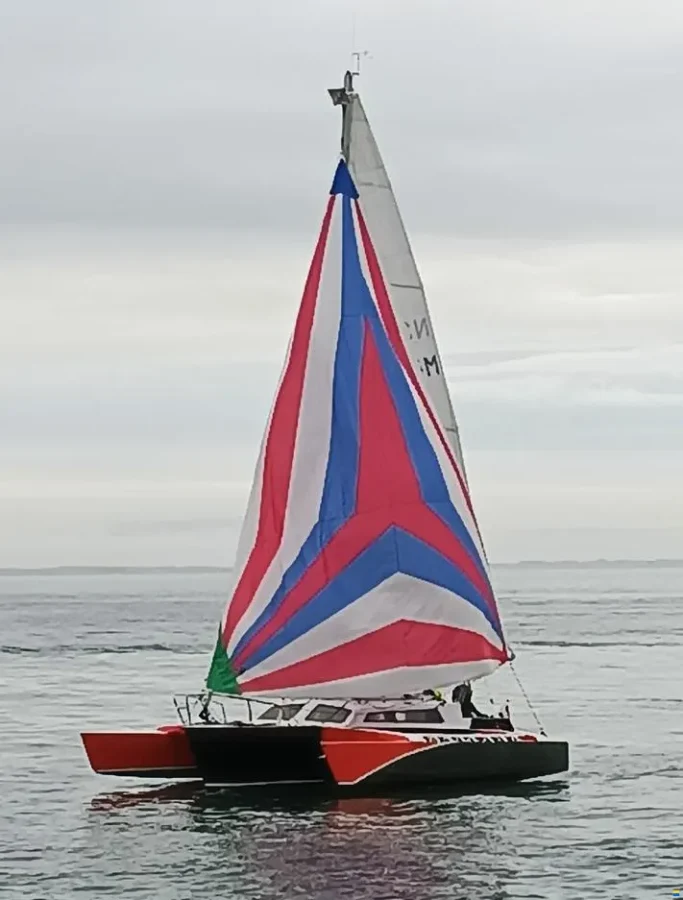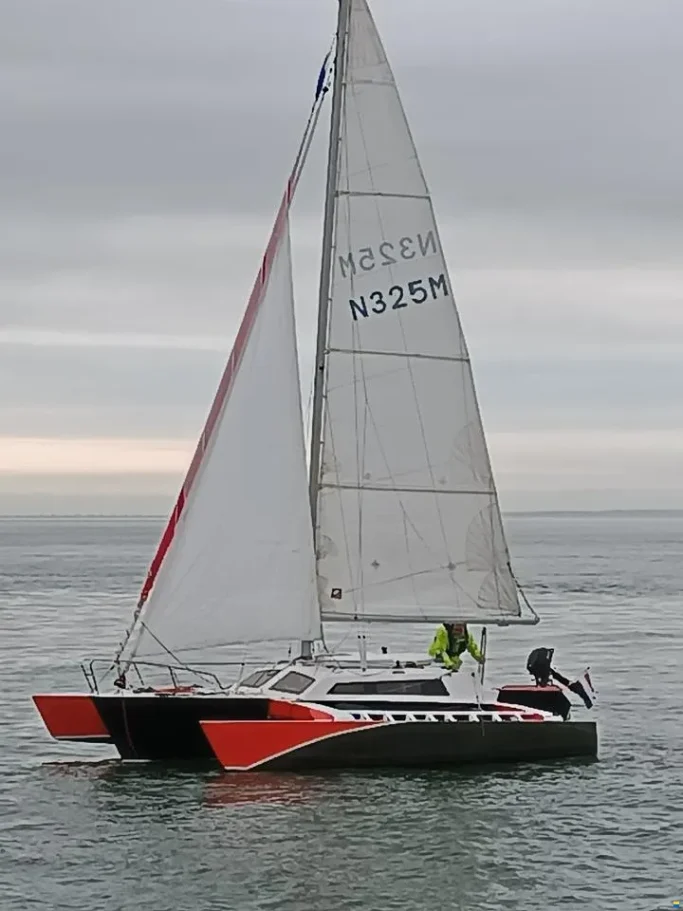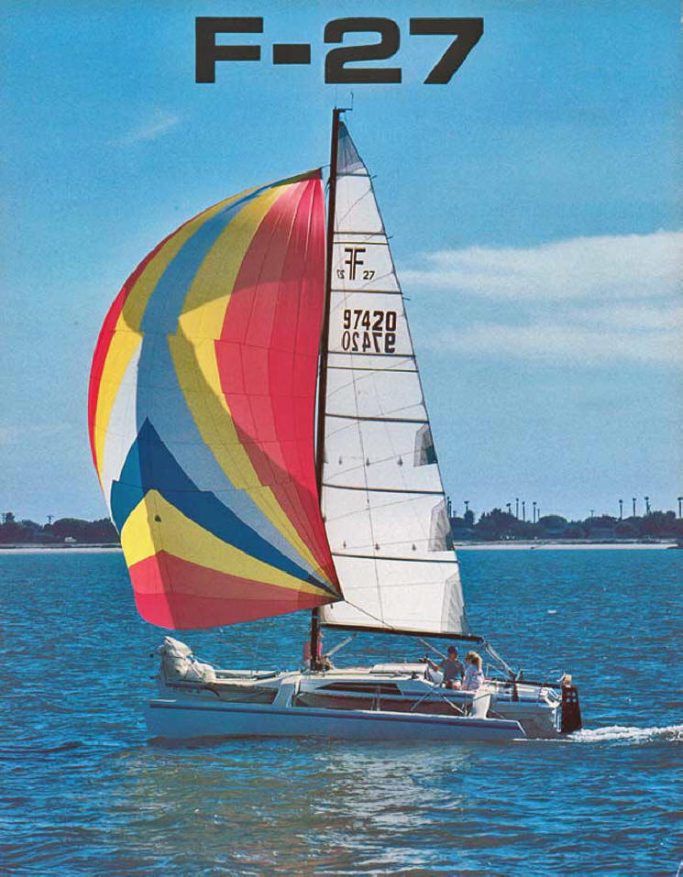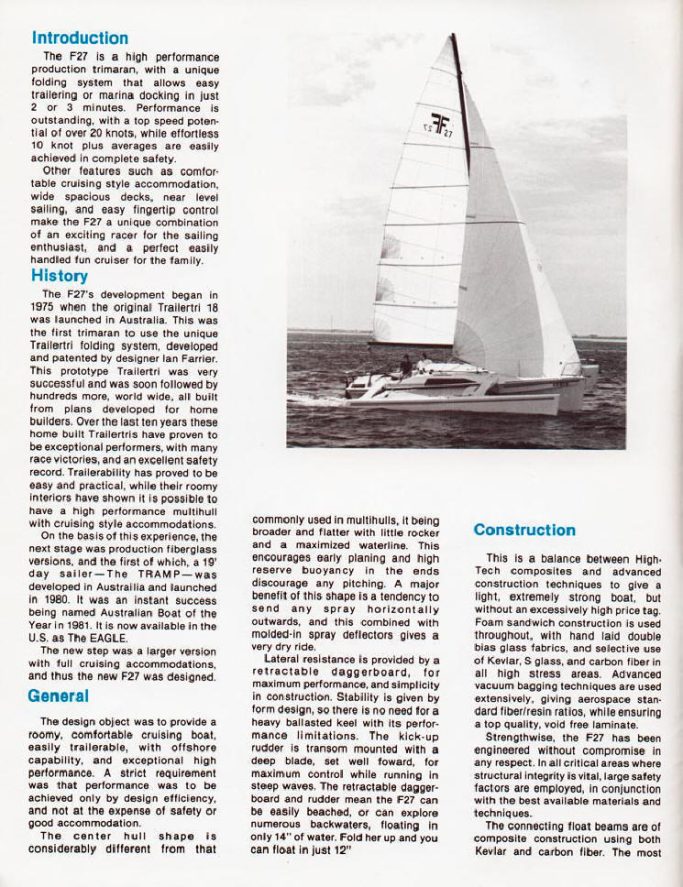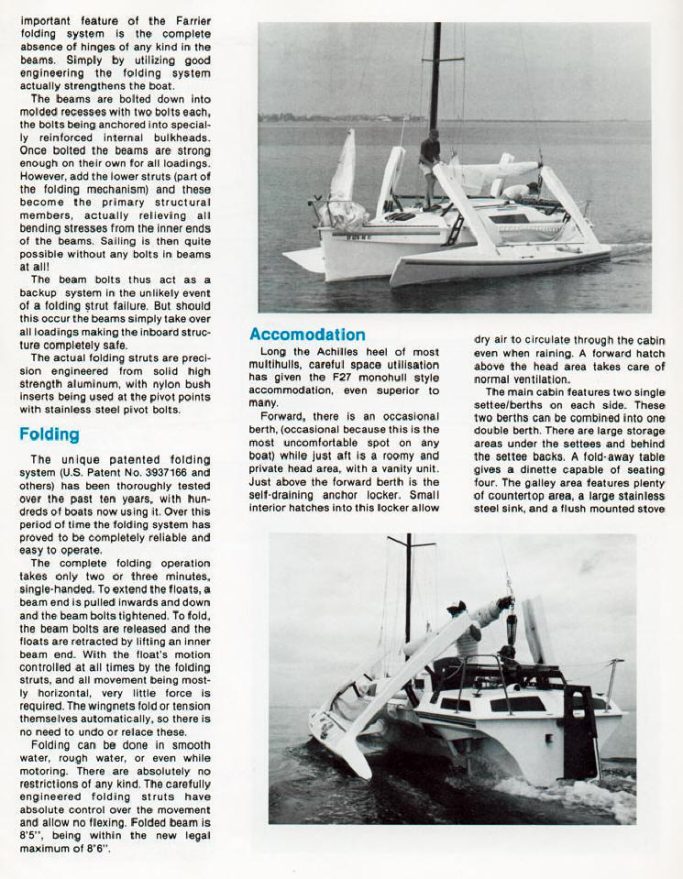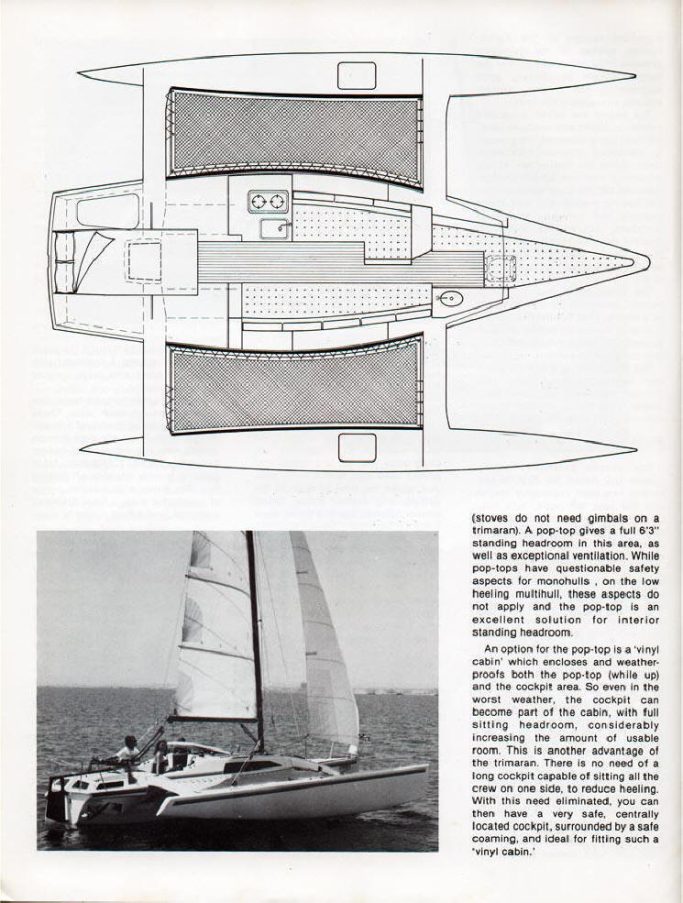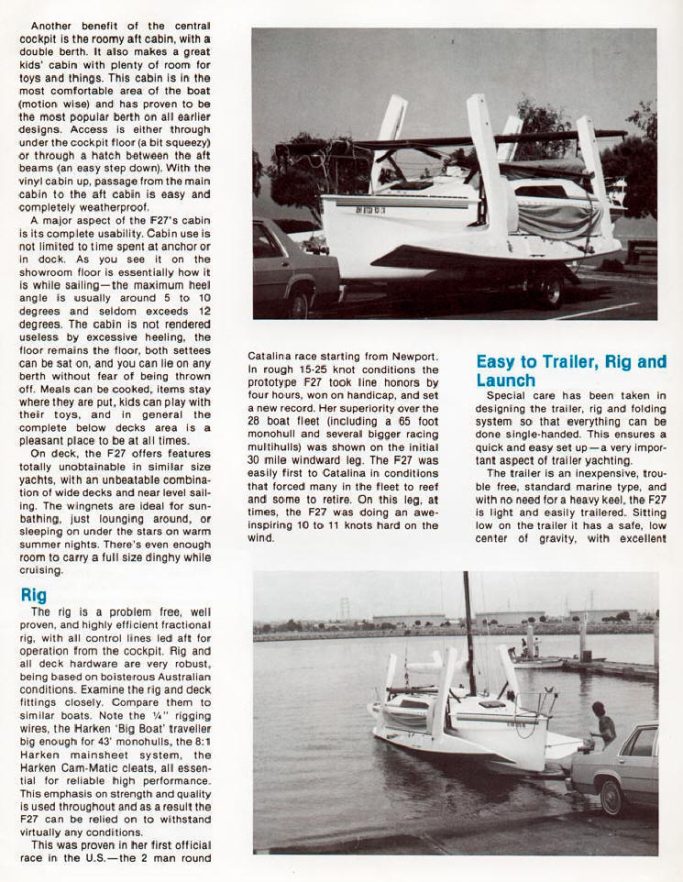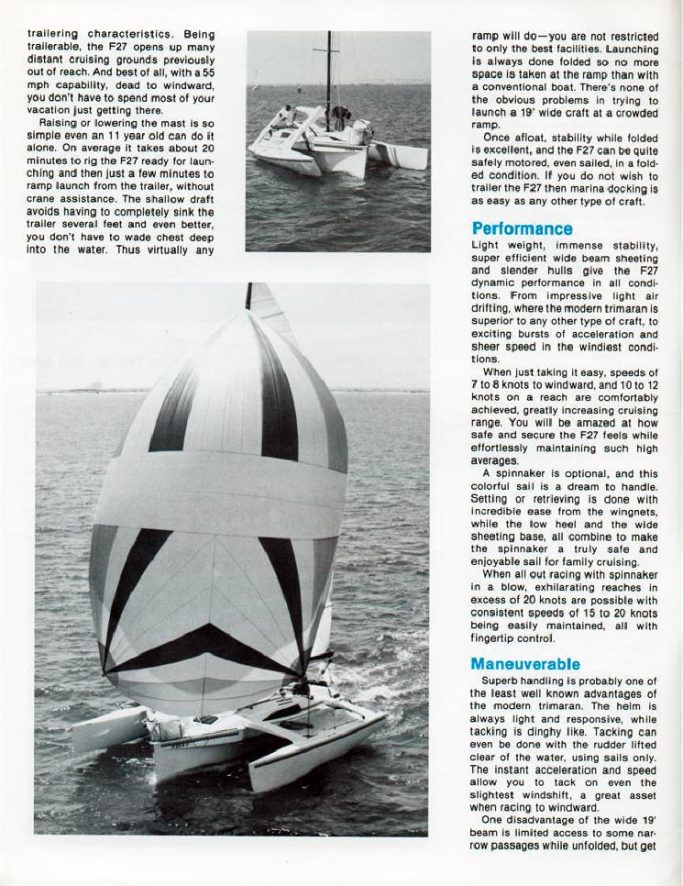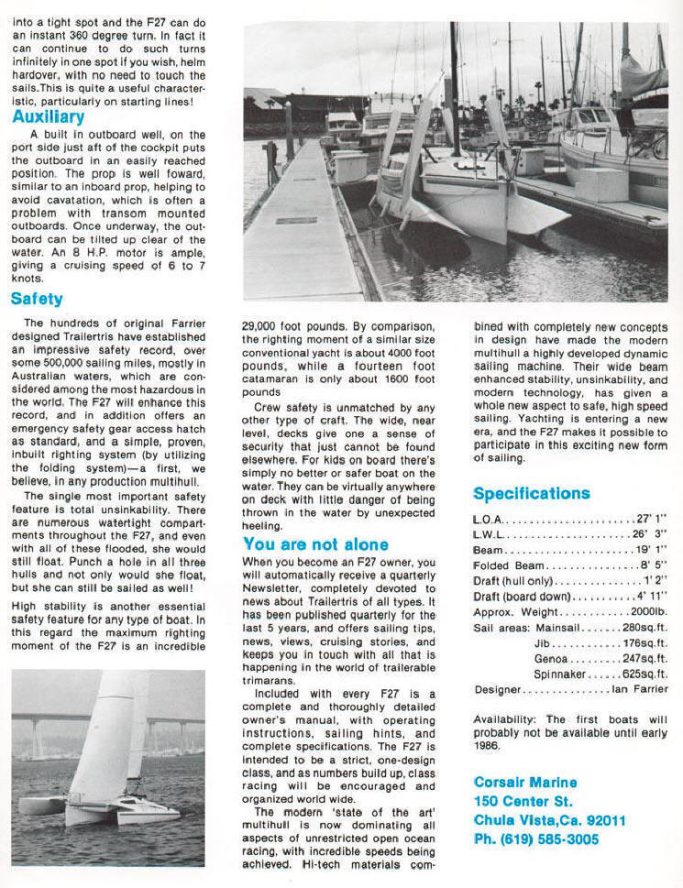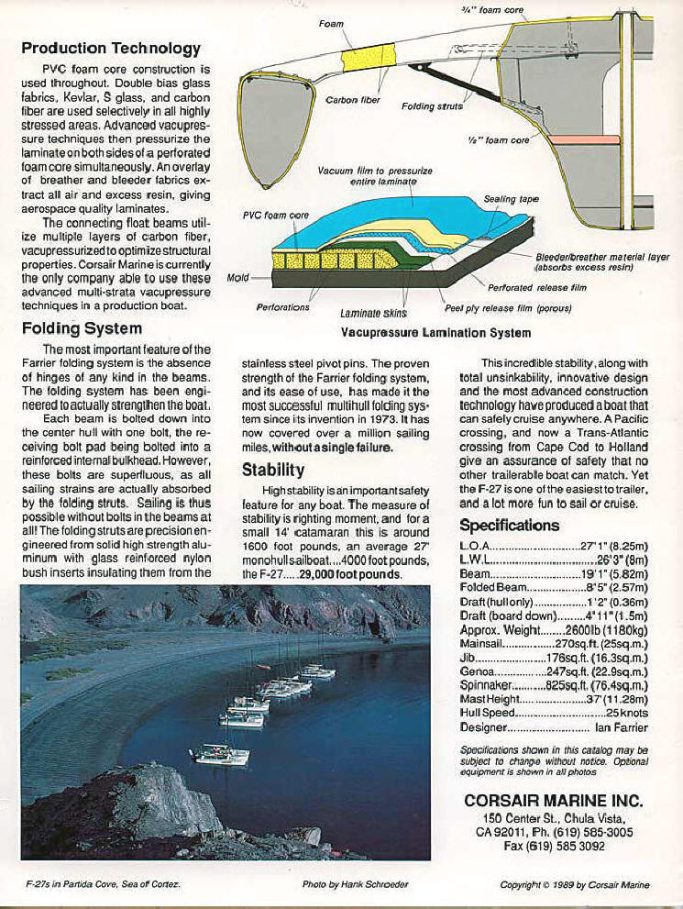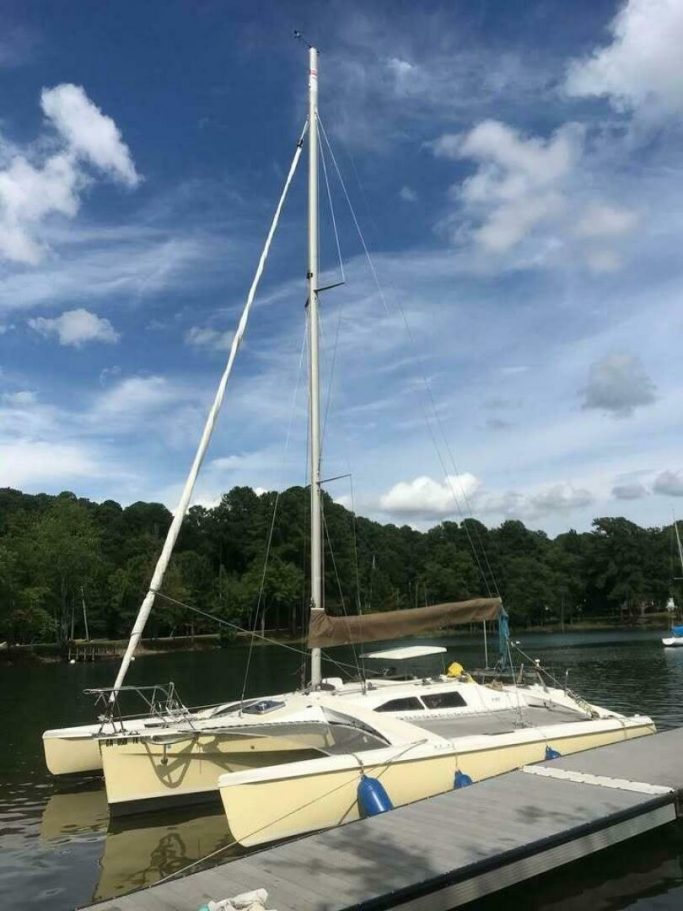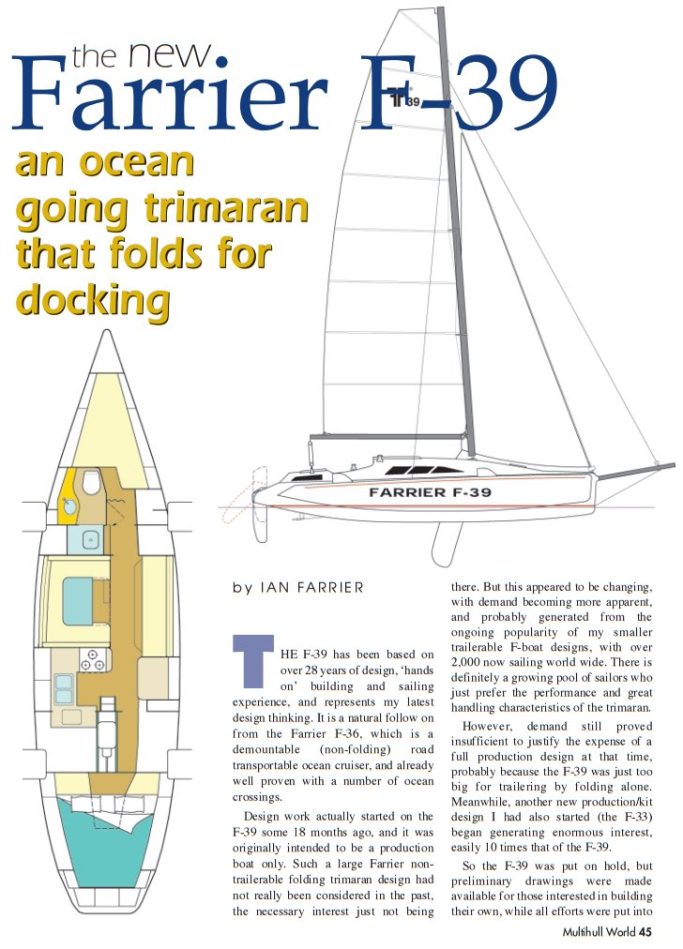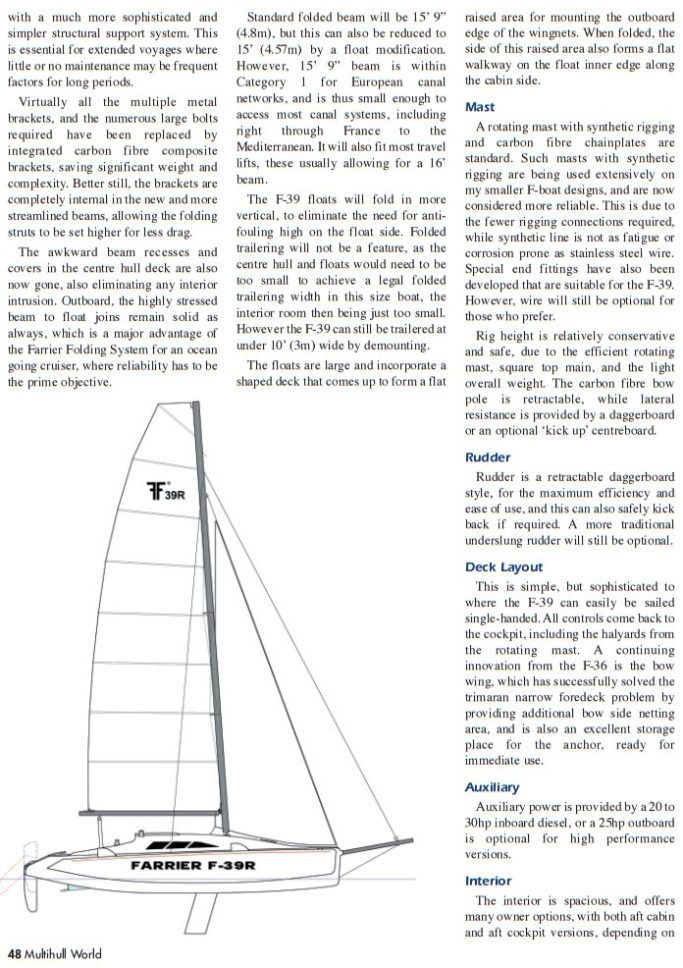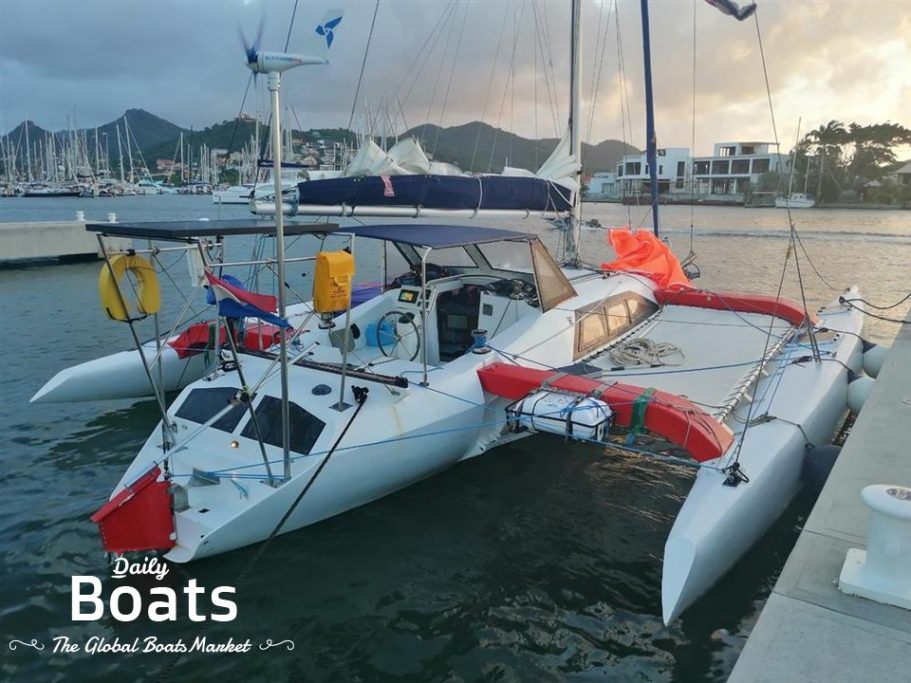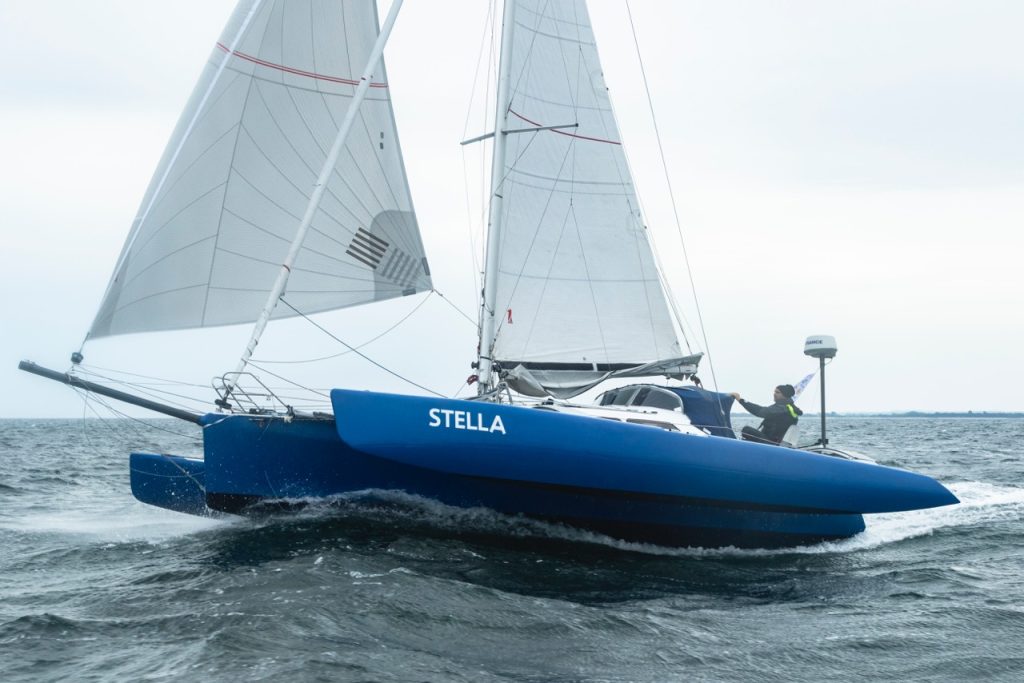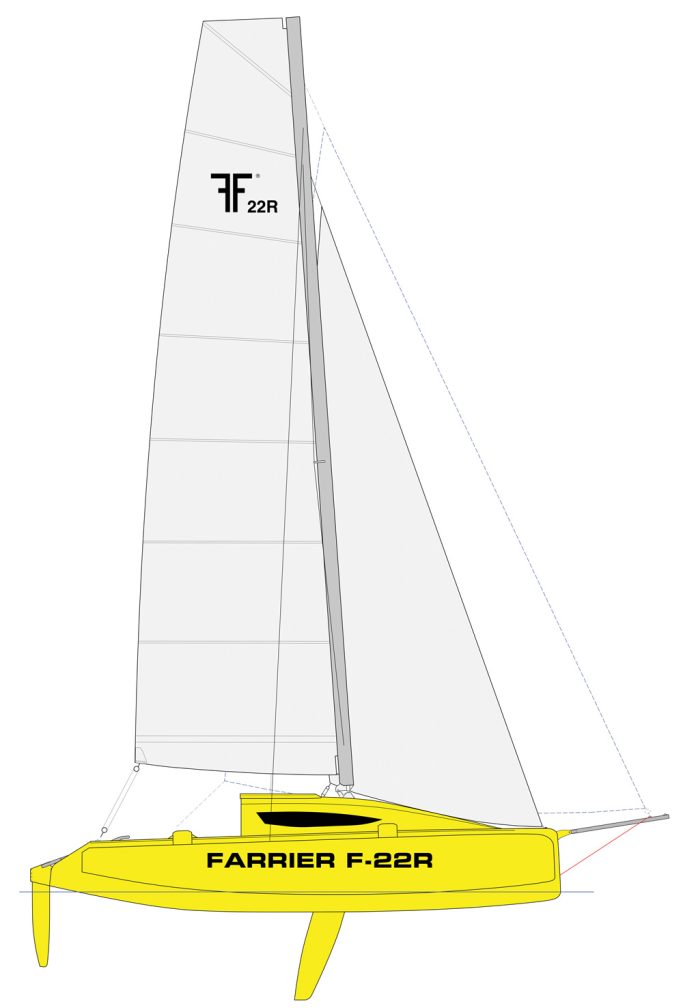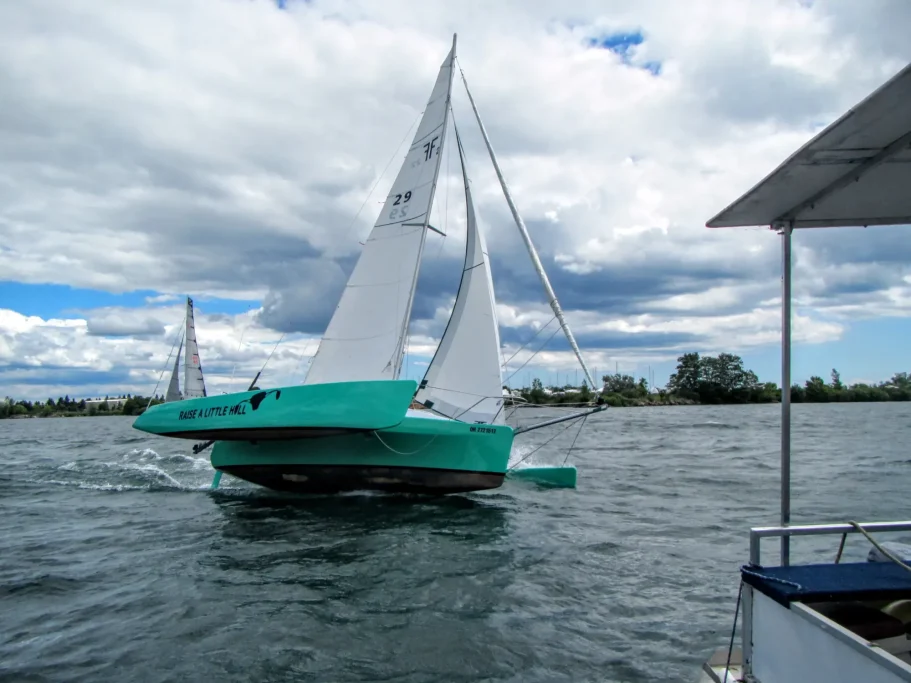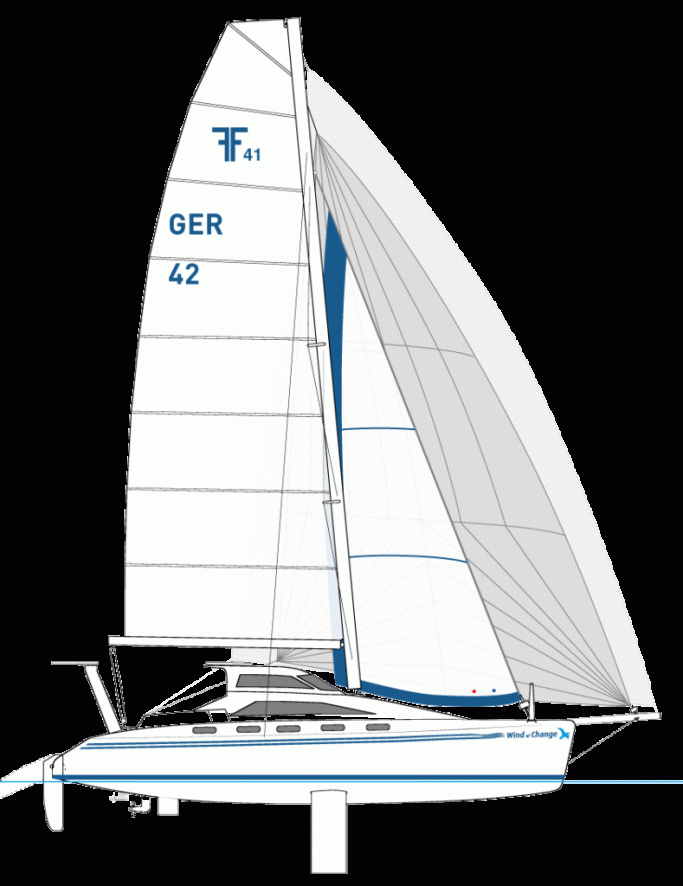Ian Farrier New Zealand 1947 to 2017
Ian Farrier came on the scene a little later than most of the other pioneers on this website and his story begins in 1973 when he invented a unique system for a folding trimaran that could very its beam and fold the outriggers for transport and berthing. Starting with a design series called the Trailertri, Ian went on produce Australia's first grp trimaran the Tramp. In 1984 he partnered with US manufacturer Corsair and developed the F27 which was the first of a large range of folding trimarans. Later Ian set up Farrier Marine in New Zealand.
In 2001 there was a slightly less than happy breakaway from Corsair who continued to use his patented folding mechanism. Ian sold plans for a range of trimarans right up to the F36 and its development the F39 which were Ocean going vessels.
Eventually he also produced large catamaran designs before withdrawing from the home build market altogether to start production of an F22 model in 2012. He also designe dthe F32 for production too. Sadly his untimely death in 2017 means that while the company he founded continues to sell the F 22 the plans for his extraordinary range of designs are no longer available. The Company statement in 2019 said:
Ian Farrier’s death in 2018 was untimely – but he has left an enduring legacy in folding trimarans.
New Zealand has a great history of producing talented yacht designers. While most are known here well before they gain international success, Ian Farrier established his reputation for designing ground-breaking folding trimarans overseas.
When he passed away suddenly last year, Farrier left an admirable legacy of well-designed boats that have won some prestigious awards and many hearts. This legacy is built on the power of well-thought-out boats perfected by equally well-thought-out detail. As a young engineering student, Farrier launched his first trimaran in 1969 after two years of hard work. He had been in the market for a small keeler but his engineering mind had balked at their inherent inefficiency. He endured a few hidings in his new boat offshore and crewed on a 38-foot keeler bound for Tonga, which further refined his design thinking on what an efficient yacht could be.
In 1972 he arrived in Brisbane, Australia, where the growing popularity of the monohull trailer sailer was in full swing. To Farrier’s immaculate design mind a trailerable trimaran appeared to have many advantages over trailerable monohulls and it was in this hybrid of ideas that he saw an opportunity to design something not seen before.
The result was the Farrier Folding System™, which was patented in 1975 and became an integral part of the Trailertri 18 – built and launched in 1976. This ground-breaking design was quickly followed by the 680 and 720 designs and capped off with his first fibreglass production design, the Tramp.
In 1984 Farrier and his family moved to San Diego and with partners set up Corsair Marine. By then his folding trimaran concept was well-proven and ripe for going into large-scale production. He then designed the F-27, built the prototype, and developed and established Corsair’s full production system and quality controls.
The F-27 was a game changer and the early racing success of the prototype Super Fox got Farrier noticed by the more conservative yachting establishment. Versatility and performance were the strengths of this design, which allowed easy towing or fitting into a conventional marina berth in her folded configuration.
One of the first multihulls to be accepted into the mainstream of sailing, the F-27 paved the way for success of the folding trimaran concept. In 2004 the F-27 was inducted into the American Sailboat Hall of Fame and named as one of the four most influential designs of the past 50 years by Robert Perry of Sailing magazine.
Farrier resigned from Corsair in 1991 and moved to Western Australia to concentrate on his new design the F-9A which was an extension of the F-27 idea. This then became the F-31 production boat produced by Australian company OSTAC.
...it was in this hybrid of ideas that he saw an opportunity to design something not seen before.
One of the first multihulls to be accepted into the mainstream of sailing, the F-27 paved the way for success of the folding trimaran concept.
In 1992 the F-31 was judged Australian sailboat of the year. There was a brief foray back to help Corsair Marine under new management in 1994 with Farrier restoring the design specifications and production standards of the F-31 and F-24 before again parting ways with Corsair Marine for good in 2000.
By 2010 the first production F-22 was completed after a six-year gestation period. Farrier spent these years in R&D getting the design details spot on. Seeing the R&D focus of the business transforming into production, he began talks with Michael Reardon, CEO of US company Daedalus Yachts. A deal was reached in principle to purchase the company and the production of the F-22 line before Farrier’s untimely passing.
While his death threw his lifetime of achievements into stark light, it also left uncertainty about Farrier Marine’s future. With the Christchurch F-22 factory in a vulnerable phase between design and production and a large order book to fill, the facility’s general manager (Robin Densem) managed to not only keep the Christchurch factory going but also secure the deal with Daedalus Yachts that Farrier had initiated.
Densem says the opportunity for Farrier Marine to work with Daedalus Yachts is good news for Farrier fans. Daedalus Yachts has elected to keep production going in New Zealand and supplement this with additional production of the F22 and other designs in their factory at Edenton, North Carolina.
“Working with Daedalus will give us a secondary production facility to complement the Christchurch one, and so increase production of the F-22,” says Densem. “There is a high demand for F-22s internationally and the inclusion of our Daedalus Yachts team in North Carolina will enable us to ramp up production using the latest design and technology to enhance our production methods and the environmental sustainability of the F-22 production.”
Says Michael Reardon, CEO of Daedalus Yachts: “We have an incredibly talented and technically advanced team in both Christchurch and our Edenton boat building campus. We are dedicated to producing F-22s to Ian’s extremely high standards, as well as developing new models from his drawing board. This will ensure the Farrier Marine reputation thrives into the future.”
Not long after the new business structure was in place, the F-22 appeared at the recent Annapolis Boat Show and won Sail magazine’s Best Small Cruiser, 2019. I suspect this will be the first of many awards for this brilliant design.
Through his design collaborations with production builders, custom builders and his own companies, Ian Farrier was responsible for more than 3000 sailing multihulls afloat today.
His designs were continually evolving game-changers in the world of sailing and will, thanks to the work of Michael Reardon and Robin Densem, continue to evolve. Their timeless nature inherent in the great design will continue the legacy of safe, innovative and beautifully engineered sailing machines.
The Evecom Multihulls site set out the following detailed history:
History of Farrier Trimarans till F-27
(1970-1991)
1970: Designer Ian Farrier sails his 30' trimaran single-handed up the coast of New Zealand encountering several mid-winter' roaring forties' storms. These were valuable experience in the multihulls behavior in bad weather offshore.
1970: Sails from New Zealand to Tonga on a 38' monohull. Storm and general sailing experience on this trip convinces designer (initially a monohull sailor) that properly designed and engineered multihulls are the craft of the future.
1973: Invents new trimaran folding system and applies for patent
1974: The original Trailertri Prototype built and launched by designer in Australia.
1975: Farrier Folding System™ patent granted
1976: The first Trailertri 18 built by designer
1977: The first Trailertri 680 built by designer
1980: The first production fiberglass Farrier trimaran (the TRAMP) developed and launched. Judged Australian Boat of the Year in 1981.
1983: Trailertri 720 introduced
March, 1984: Ian Farrier moves to the U.S. to set-up Corsair Marine, while vice president, to develop and build his F-27 trimaran design.
May, 1985: The prototype production F-27 SUPER FOX launched.
July, 1985: Ian Farrier sails SUPER FOX to a new race record in her first official event - The Two Man Around Catalina Race. The F-27 trimaran took line honors by 4 hours, and won on handicap, from a fleet of mostly bigger boats, including a maxi (65') ULDB monohull. Starting last, the F-27 overhauled the entire monohull fleet on the first 30 mile windward leg in very choppy 20 to 25 knot conditions.
July, 1986: SUPER FOX demonstrates the F-27's great versatility by again winning the Two Man Around Catalina Race, but this time in very light conditions. It gave such boats as a McGregor 65, S & S 51, Frers 46, and C & C 42, 15 minutes start, yet still caught and passed them all. The F-27 was the only boat fast enough to finish within the time limit.
June, 1987: The first ocean crossing by an F-27. Mark Robson's KILLER FROG sails in the Trans Pac Race from Long Beach to Hawaii. Averages just on 8 knots for a quick 12 day passage, including one 250 mile day. It should be noted that while it is nice to know that the F-27 is capable of such long ocean crossings in experienced hands, it still remains a small trailerable yacht and is not recommended or intended for this purpose.
July, 1988: The second ocean crossing, this time across the Atlantic. Adrian Went's F-27 OLIJFE makes an impressive passage of 23 days from Cape Cod to Bishop Rock, England and then on up through the English Channel to Holland.
April 1989: The F-27 CORSAIR wins the multihull division of the Newport - Ensenada Race, the first time a production trimaran has done this.
May 1990: The F-27 recognized by the Nippon Ocean Racing Club as an official class - the first trimaran to be so recognized.
July, 1990: Two more F-27s cross the Pacific to Hawaii, one singlehanded, one doublehanded.
April, 1990: The F-27 AQUATEC easily wins the Australian Multihull Offshore Championships, a series of 7 races. AQUATEC is the first trailerable multihull to do this.
August 1990: F-27s are the first multihulls invited to compete in the Audi National Offshore One Design Regatta, (N.O.O.D) organized by SAILING WORLD and held at Newport, Rhode Island.
March, 1991: Having established Corsair Marine, its productions systems, and reputation, with 100 F-27s being produced every year, but with growing concerns about company directions, Ian Farrier resigns from Corsair Marine. New management takes over at Corsair, and is licensed to build F-24.
June, 1991: Dr. Werner Stolz and Roswitha Schadt's F-27 becomes the second F-27 to cross the Atlantic.
September, 1991: With Corsair Marine's owner John Walton and new management trying to redesign F-24 and also design their own larger trimaran, Ian Farrier disassociates to concentrate on his latest design, the F-9A, which is launched in Australia. This is then developed into the production F-31 via the licensed Australian builder OSTAC.
Over 3000 Farrier designs were built around the World and were hugely popular. The F36 circumnavigated and many farrier designs crossed Oceans. Ian was the first to point out that only the f36 and F39 were designed to be ocean going boats.






















